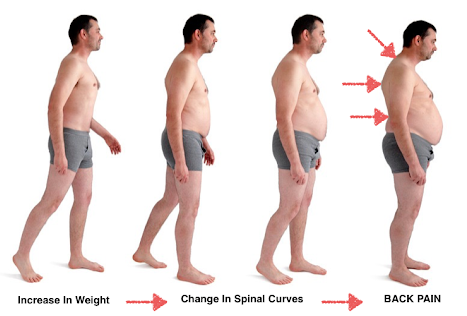Back and hip pain after weight loss can result from muscle imbalances and poor posture. Strengthening exercises and proper posture can help alleviate discomfort.
Losing weight is a significant achievement, but it can sometimes lead to unexpected issues like back and hip pain. As the body adjusts to a lower weight, muscles and joints may experience strain due to imbalances or poor posture. This discomfort can hinder daily activities and quality of life.
Incorporating strength training and maintaining proper posture can mitigate these issues. Consulting a healthcare professional can provide personalized advice and exercises tailored to your needs. Addressing these concerns early ensures that your weight loss journey remains positive and health-focused.
Causes Of Back Pain
Losing weight can bring joy and confidence. Yet, some people suffer back pain after shedding pounds. Understanding the causes can help you find relief and prevent further issues.
Muscle Imbalance
Muscle imbalance often occurs after weight loss. Fat loss can lead to uneven muscle strength. Some muscles may become weaker, causing strain on the back. For example, weak abdominal muscles can lead to back strain. This imbalance disrupts the body’s natural alignment. Exercises targeting all muscle groups can help.
Poor Posture
Poor posture is another common cause of back pain. Weight loss can change your body’s alignment, leading to postural issues. Slouching or sitting improperly can strain your back muscles. Proper posture ensures your spine stays aligned. This reduces the risk of pain. Consider using ergonomic furniture or practicing posture exercises.
Causes Of Hip Pain
Weight loss can bring unexpected hip pain. Understanding the causes helps manage discomfort better. Two main causes are joint stress and tendonitis.
Joint Stress
Joint stress occurs due to sudden weight changes. Your hips carry your body weight. Losing weight rapidly can change how your joints move.
When you lose weight, your body needs time to adjust. Your hip joints might not align properly, causing pain. Maintaining a steady weight loss pace helps reduce joint stress.
| Joint Stress Factors | Description |
|---|---|
| Rapid Weight Loss | Body needs time to adjust |
| Misalignment | Hips might not align properly |
| Body Weight Carry | Hips carry your body weight |
Tendonitis
Tendonitis is inflammation of the tendons. Tendons connect muscles to bones. Overuse or sudden changes in activity can cause tendonitis.
After losing weight, you might increase your physical activity. This can strain the tendons around your hips, causing pain. Gradual increases in activity levels help prevent tendonitis.
- Overuse: Increased activity levels cause strain.
- Inflammation: Tendons become inflamed, leading to pain.
- Sudden Changes: Rapid changes in activity stress tendons.
Weight Loss And Pain Connection
Losing weight can bring unexpected challenges. One such challenge is pain. Many people experience back and hip pain after losing weight. This can be surprising and confusing. Understanding the link between weight loss and pain is essential.
Rapid Weight Loss Impact
Rapid weight loss can strain the body. The body needs time to adjust. Losing weight too fast can lead to muscle weakness. Muscles support the back and hips. Weak muscles can cause pain in these areas.
- Muscle loss: Rapid weight loss can lead to muscle loss.
- Joint stress: Less muscle means more stress on joints.
- Posture changes: Sudden weight loss can change posture.
Nutritional Deficiencies
Nutritional deficiencies can occur during weight loss. A balanced diet is crucial. Lack of essential nutrients can lead to pain.
| Essential Nutrient | Impact on Pain |
|---|---|
| Calcium | Weak bones can cause back pain. |
| Magnesium | Muscle cramps can lead to hip pain. |
| Vitamin D | Low levels can cause bone pain. |
Ensuring a balanced diet is crucial. Always monitor nutrient intake during weight loss. This can help prevent pain.
Preventive Measures
Experiencing back and hip pain after weight loss can be frustrating. However, there are effective preventive measures to help avoid such discomfort. These measures focus on maintaining a healthy lifestyle through proper exercise techniques and a balanced diet.
Proper Exercise Techniques
Engaging in regular exercise is essential, but using the right techniques is crucial to prevent pain. Here are some tips to ensure your exercises are safe and effective:
- Warm-up before starting any workout.
- Maintain good posture during exercises.
- Use proper form to avoid strain on your back and hips.
- Incorporate strength training to support your back and hip muscles.
- Cool down and stretch after workouts to prevent stiffness.
Balanced Diet
A balanced diet supports overall health and helps maintain muscle strength. Here are some dietary tips to prevent back and hip pain:
- Include a variety of fruits and vegetables.
- Ensure adequate protein intake for muscle repair and growth.
- Stay hydrated to keep muscles and joints lubricated.
- Limit processed foods and sugars.
- Consume healthy fats to support joint health.
By following these preventive measures, you can reduce the risk of back and hip pain and enjoy a healthier lifestyle after weight loss.
Effective Treatments
After losing weight, you might experience back and hip pain. This can be due to changes in body mechanics or muscle imbalances. Addressing this pain early is crucial. Here, we explore effective treatments to help you find relief.
Physical Therapy
Physical therapy can be a game-changer for back and hip pain. It helps improve strength and flexibility. A physical therapist will create a custom plan for you.
- Strengthening Exercises: Build core muscles to support your spine.
- Stretching: Improve flexibility to reduce tension and pain.
- Posture Training: Learn to maintain proper posture to avoid pain.
Regular sessions with a physical therapist can make a big difference. They can monitor your progress and adjust your plan as needed.
Pain Management
Pain management techniques can provide immediate relief and long-term benefits. These methods can help you stay active without discomfort.
- Over-the-Counter Medications: Use ibuprofen or acetaminophen for quick relief.
- Heat and Ice Therapy: Alternate between heat and ice packs to reduce inflammation.
- Massage Therapy: Relieve muscle tension and improve blood flow with massages.
For chronic pain, consider seeing a pain specialist. They can offer advanced treatments, like injections or nerve blocks.
| Method | Benefits |
|---|---|
| Physical Therapy | Improves strength, flexibility, and posture. |
| Pain Management | Provides immediate relief and long-term benefits. |

Lifestyle Adjustments
Weight loss is a fantastic achievement, but it can lead to unexpected pain in the back and hips. Making lifestyle adjustments can help alleviate discomfort and promote long-term health. Here are some key areas to focus on.
Ergonomic Changes
Proper ergonomics can make a huge difference. Adjust your workspace to support your back and hips.
- Chair: Use an ergonomic chair that supports your lower back.
- Desk: Ensure your desk height allows your elbows to be at a 90-degree angle.
- Monitor: Place your monitor at eye level to prevent neck strain.
Consider using a standing desk to vary your posture. Alternate between sitting and standing every 30 minutes.
Healthy Habits
Adopting healthy habits can prevent and reduce pain.
- Exercise: Include low-impact exercises like walking, swimming, or cycling.
- Stretching: Do daily stretches focusing on your back and hips.
- Hydration: Drink plenty of water to keep your muscles hydrated.
Maintain a balanced diet rich in vitamins and minerals. Foods high in calcium and magnesium support bone health.
Get enough sleep. A good mattress can support your back and hips properly.
| Adjustment | Benefit |
|---|---|
| Ergonomic Chair | Supports lower back |
| Standing Desk | Reduces prolonged sitting |
| Low-Impact Exercise | Strengthens muscles |
| Hydration | Keeps muscles hydrated |
When To Seek Professional Help
Weight loss can sometimes lead to unexpected back and hip pain. This pain might be a sign that your body needs help. Understanding when to seek professional help is important. Here are some indicators and tips on choosing the right specialist.
Persistent Pain Indicators
- Constant Pain: If the pain does not go away after a few days.
- Severe Pain: Pain that is very intense or unbearable.
- Limited Mobility: Trouble moving or doing daily activities.
- Numbness or Tingling: Feeling numb or tingling in your back or hips.
- Swelling or Redness: Visible swelling or redness in the pain area.
Choosing The Right Specialist
Finding the right specialist can make a big difference. Here are some options:
| Specialist | Expertise |
|---|---|
| Orthopedic Doctor | Treats bones, joints, and muscles. |
| Physiotherapist | Helps with exercises and physical therapy. |
| Chiropractor | Focuses on spine and joint adjustments. |
| Rheumatologist | Treats arthritis and joint disorders. |
Discuss your symptoms with your primary care doctor. They can guide you to the right specialist. Seeking help early can prevent further issues.


Frequently Asked Questions
Why Do I Have Back Pain After Weight Loss?
Back pain after weight loss can occur due to muscle imbalances. Rapid weight loss may weaken core muscles, leading to poor posture.
Can Weight Loss Cause Hip Pain?
Yes, weight loss can cause hip pain. This happens if you lose muscle mass, leading to decreased support for your hip joints.
How Can I Relieve Back Pain After Losing Weight?
To relieve back pain, strengthen your core muscles with targeted exercises. Maintain a balanced diet to support muscle health.
Is It Normal To Feel Hip Pain After Weight Loss?
Feeling hip pain after weight loss is not uncommon. It often results from decreased muscle mass and altered biomechanics.
Conclusion
Relieving back and hip pain after weight loss involves proper exercise and posture. Focus on strengthening core muscles. Consult a physical therapist for personalized guidance. Incorporating these strategies can help maintain a pain-free lifestyle. Remember, your health journey is unique, and small adjustments can make a significant difference.
written by: deshily.com